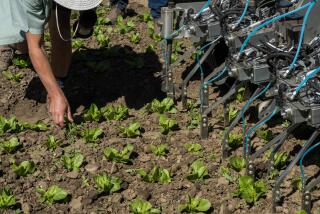New Echoes of That Silent Spring : United States must move away from pesticide use in food
Three federal agencies last month announced plans to reduce the use of chemicals in the production of the nation’s food. In their place, the government will promote “sustainable agricultural practices” that rely on nature’s own forces to control pests. This change of direction is wise, if long overdue.
As part of this new initiative, the Agriculture Department, the Food and Drug Administration and the Environmental Protection Agency--agencies that have been at odds over the use of agricultural chemicals in recent years--will now work together. They will create incentives for the development of safe pesticides and the use of “integrated pest management,” a farming method that substitutes the use of beneficial insects and crop rotation for some pesticides. In addition, they will remove from the market those pesticides posing the greatest health dangers.
The announcement represents a major change in U.S. pesticide policy. Until now, there has been no coordinated effort among the agencies, except when concerns about individual pesticides have raised public alarm. Indeed, since Rachel Carson issued her prophetic warning 30 years ago in “Silent Spring,” her book about the dangers of chemical pesticides, research on pesticide safety has been flawed and unacceptably slow.
One result? Infants and children may be at particular risk, according to a new study from the National Academy of Sciences, released just after the government’s announcement. Pesticide tolerance levels have typically been based on research using adults; children often eat proportionally more fruits and vegetables than adults and, according to the study, “there should be a presumption of greater toxicity to infants and children.” Reports last month from the Natural Resources Defense Council and the nonprofit Environmental Working Group identified similar problems.
Moreover, as these studies show, the process by which pesticides are licensed has been cumbersome, driven as much by tradition as scientific research, and is often subject to undue influence by the chemical industry and agricultural interests.
As a result, U.S. pesticide use has doubled over the last three decades in the aggregate as well as, more ominously, in the number of pounds applied to each acre of harvested land. In 1966, 1.2 pounds of pesticide was used on each acre; by 1991, that figure jumped to 2.7 pounds per acre. Measuring another way, eight pounds of pesticides were used for every American.
Several European nations have made major strides in cutting pesticide use in recent years. Now, this nation must make meaningful progress in the same direction.
More to Read
Sign up for Essential California
The most important California stories and recommendations in your inbox every morning.
You may occasionally receive promotional content from the Los Angeles Times.










